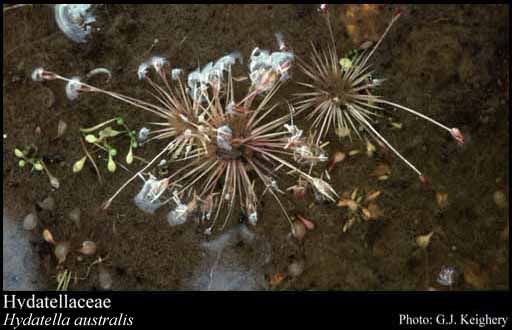- Reference
- New Zealand J.Bot. 14:195 (1976)
- Name Status
- Current

Scientific Description
Common name. Hydatella Family.
Family Sometimes included in Centrolepidaceae.
Habit and leaf form. Aquatic herbs. Glabrous annual; plants with a basal concentration of leaves (the stems very short). Hydrophytic to helophytic; rooted. Leaves submerged and emergent; alternate; spiral; sessile; sheathing. Leaf sheaths not tubular; with free margins. Leaves simple; epulvinate. Leaf blades entire; sub- solid, or flat; linear; parallel-veined. Leaves eligulate; presumably with a persistent basal meristem, and basipetal development. Vegetative anatomy. Plants without silica bodies. Stem anatomy. Secondary thickening absent.
Reproductive type, pollination. Fertile flowers functionally male and functionally female. Unisexual flowers present. Plants monoecious (the heads mixed in Trithuria, mostly unisexual in Hydatella). Floral nectaries absent (nectaries lacking). Autogamous or pollinated by water.
Inflorescence and flower features. Flowers aggregated in ‘inflorescences’; in heads; more or less in ‘spikelets’. Inflorescences usually more or less scapiflorous; terminal; with involucral bracts; pseudanthial. Flowers bracteate; ebracteolate; small; 1 merous. Hypogynous disk absent. Perianth absent. Fertile stamens present, or absent (female flowers). Androecium 1 (i.e. the male flower consisting of a single stamen). Androecium exclusively of fertile stamens. Stamens 1. Anthers basifixed; non-versatile; dehiscing via longitudinal slits; bilocular; tetrasporangiate. Fertile gynoecium present, or absent (male flowers). Gynoecium ostensibly 1 carpelled. The pistil 1 celled. Gynoecium monomerous, or syncarpous (perhaps pseudomonomerous, depending on interpretation); of one carpel, or eu-syncarpous; superior. Carpel 1 ovuled. Placentation apical. Ovary (if considered pseudomonomerous) unilocular; 1 locular; shortly stipitate. Gynoecium non-stylate (if a tuft of filamentous structures represents stigmas), or stylate (if it is stylar). Styles free; apical. Placentation apical. Ovules non-arillate; anatropous.
Fruit and seed features. Fruit non-fleshy. The fruiting carpel (if considered monomeric) dehiscent, or indehiscent; a follicle, or an achene (Hydatella). Fruit if considered syncarpous dehiscent, or indehiscent; a capsule, or achene-like. Capsules three valvular (Trithuria). Seeds ‘almost’ non-endospermic. Perisperm present (starchy). Seeds with starch. Embryo rudimentary at the time of seed release. Testa operculate. Seedling. Germination hypogeal (seed remnant visible at the base of the plant).
Geography, cytology, number of species. World distribution: Western Australia, New Zealand. 3 species.